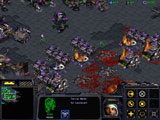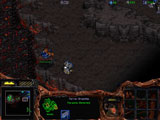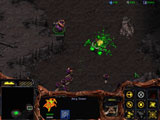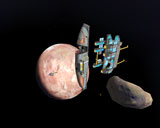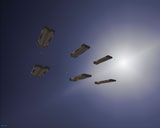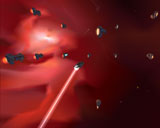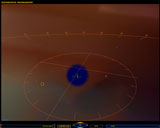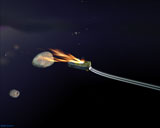About
This page, as its title implies, is about games. This is not (intended to be) a game reviews page; rather, this page is an attempt to spark an interest in computer games, and is primarily aimed at people who are completely unfamiliar with them.
One of the main reasons why computer games are fun is that they allow you to do stuff that you normally wouldn't be able to do, for a number of reasons. For instance, the game may take place in the past or in the future, it may take place in another country, on another planet, in another galaxy, or in another entirely fictional universe altogether. It may place you in the shoes of a theoretical physicist fighting off alien invaders from another dimension, it may place you in the shoes of a Persian prince trying to save the princess by doing insane acrobatics and fighting sand monsters, or it may place you in the shoes of a nano-technologically augmented super-agent fighting terrorism across continents and tracking conspirators across the globe. If you are a theoretical physicist, a Persian prince, or a nano-augmented agent, congratulations. If not, you'll be glad computer games exist to enable you to experience what you otherwise would not.
This page features tons of pictures. Don't worry, this is perfectly normal and completely intentional; I try to promote the games mostly by visuals, and you need examples of what the games look like if you're ever going to be interested in them.
Note that this page is very subjective; I play mostly first-person shooters, a few real-time strategy games, and a few puzzle games, and hence these are the genres on which this page will mostly focus. There are, of course, good games in other genres. While I'm sure the games are good, I simply don't like them because of the genre (an example is Diablo 2, which is a role-playing game and I hear it's a very good one). Another side of this subjectiveness is the fact that I've never owned a console, and while I know there are many good games for consoles (such as the exhilarating Crash Bandicoot series for the PlayStation or Goldeneye for the Nintendo 64), I won't be writing about them here. In addition, I live and breathe science fiction, so naturally this page features a lot of science fiction games.
I firmly believe that writing about games I don't like or don't immensely enjoy would only subtract from the quality of this page.
Games
Halo
“Did you sleep well?”
“No thanks to your driving, yes.”
“So you did miss me.”
In these two first-person shooters, you assume the role of John-117 (consistently referred to as Master Chief in the games), a Spartan II super soldier outfitted in a MJOLNIR MK 5 battle suit (MK 6 in the sequel). While in cryo sleep aboard the starship Pillar of Autumn, the ship gets attacked by the Covenant, and the captain on the ship, Jacobs Keyes, thaws you up. The ship is under so heavy an attack that Keyes decides to try to land the Autumn on a ring-world they've spotted (called Halo), while assigning you the safekeeping of the ship's AI, Cortana. You make it to a life boat and manage to land on Halo. This is where the game proper begins.
The rest of the game is trying to figure out Halo's purpose and if it can be used against the Covenant, the main enemy in the game (unfortunately, in my opinion; the Covenant would make neat allies).
This game does a lot of things right. For one thing, it has a good looking flashlight (which, for some reason, is very hard to implement in a game). It has a very compelling story. It has excellent enemy AI. It has kick ass voice acting. One of my favorite things is the contexual comments that are made during (and after) firefights. For instance, if an Elite (a very tough Covenant unit) is killed during combat, the Grunts (feeble warriors) that invariably accompany him will panic, screaming “They're everywhere!” or “I'm a cowardly fool!” while running away.
The combat is freakishly hard on the harder difficulties. Enemies will duck behind cover, regroup, and rush you if they see that you're vulnerable. This is extremely frustrating, but whenever you do finish a particularly difficult fight you'll get that “In your face, alien scum!” feeling that we all cherish.
Linkage
The Max Payne series
“They were all dead. The final gunshot was an exclamation mark to everything that had led to this point. I released my finger from the trigger. And then it was over.”
The two games in this series are third-person action games, and the gameplay mainly consists of gunning down innumerable goons. Which is fun, because the game succeeds spectacularly at it.
The first game starts with Max Payne, the games' protagonist, being framed for the murders of his wife and baby daughter (junkies high on a new designer drug, called V, really killed them, as shown in the first level). Max, an NYPD cop, goes undercover trying to find who really wanted his wife and daughter killed.
The games are very similar in style: Both are heavily influenced by the noir genre of films, and the story is communicated mainly through a graphic novel, with bobbles above the characters' heads and voice-overs to match.
The gameplay is very linear and the enemy AI isn't very impressive, but there are enough scripted sequences, obstacles, and enemies for you to really notice it. Coupled with slow motion and shoot dodge abilities, the game delivers on what the developers aimed for (an action title); at the bottom of the screen is a slow motion-meter which gets filled when you gun down bad guys, and empties when you enables slow motion (you can see bullets and avoid them) or shoot dodge (jumping sideways while shooting).
Linkage
The System Shock series
“Look at you, hacker… A pathetic creature of meat and bone. Panting and sweating as you run through my corridors. How can you challenge a perfect, immortal machine?”
This is arguably the most famous game quote of all times, and if it doesn't send a chill down your spine now, it will after you've played these two games. It is spoken by Shodan, a sentient AI construct who ran amok when her programmer removed her ethical inhibitors in the first game. The first game takes place on the space station Citadel Station, and the second game takes place on the starship Von Braun, humankind's first FTL ship, on its maiden voyage to Tau Ceti.
I have to admit that I've never finished the first game, because the controls suck so immensely (a relic of the era), so I don't have overly much to say about this game. System Shock 2, however, I have finished several times. As said, it takes place on the starship Von Braun on its maiden voyage to Tau Ceti, with the military starship Rickenbacker piggy-backed on top of it (for protection and escort). You are a marine from the Rickenbacker, but you are stored in the medical section of the Von Braun because you volunteered to be implanted with experimental cybernetic enhancements (or so Janice Polito, the Director of Human Resources, tells you; your memory is partially deleted) where you wake up and find that all the crewmembers on the ship are dead, you're 12 light years from home, you're being chased by the Many, and the onboard AI, Xerxes, has been subverted to the control of the Many. Ooops.
The game starts with you thawing up from your cryo sleep and Polito contacting you to tell you that the cryo area is about to decompress. Since being sucked into the black, vacuum void of space isn't your idea of fun, you quickly make your way out of there. If you think things are getting easier from here on, you're mistaken; you see, life forms from Tau Ceti V that the scientists from the Von Braun brought aboard have killed or infected all the crew (except you and, apparently, Janice Polito).
The immersiveness in this game is simply awesome, and the two main things this game pulls off is making you feel utterly alone and completely vulnerable. It does this by having enemies randomly spawn (but not too often, for subtlety) and having them talk to themselves when alone, and taunt you when they see you.
“Your song is not ours!”
The Many, your main enemy, is one of the coolest enemies I've encountered. It's an organic collectivist entity that incorporates other people by infecting their nervous system with annelids (quite literally; “corpus” is Latin and means “body”, and the Many physically grows when it consumes bodies), and the main theme in the game is individuality versus collectivism. It does this well; at times, even the most die-hard individualist (like me) will feel like surrendering to the Many.
If you can, play this game in the darkness and in long stretches.
Linkage
- System Shock 1 Fansite Hub
- System Shock 2 Information Hub
- Unofficial System Shock 2 Internet Headquarters
- TriOptimum Corporate Network
- Rebirth Complemented Version — More polygons for models
- SHTUP — Better textures
The StarCraft series
“En Taro Adun!”
These real-time 2D strategy games tell the epic story of three space-faring species (the Terrans, the Zerg, and the Protoss) and their struggles to survive. The Terrans are space-faring human descendants, the Zerg are vile creatures whose buildings are entirely made of organic matter (their workers mutate into these structures), and the Protoss are a highly sophisticated and advanced alien civilization. They live by a very strict religious code known as the Khala, and every member of this species is telepathically connected with everyone else (much like the Omar in Deus Ex 2).
The story in each game (StarCraft and StarCraft: Brood War) is split in three: One campaign for the Terrans, one campaign for the Zerg, and one campaign for the Protoss.
These are very balanced strategy games; no one species is really better than the other, and each species has its own unique features. For instance, the Terrans can build anywhere they want, while the Zerg have to build their structures upon an organic carpet called creep (you build Creep Colonies to expand the creep) and the Protoss have to build their structures within range of a nearby Pylon (the Pylon gives all surrounding structures energy). Another example is that the Zerg automatically regenerate their lost health as time progresses (a slow process, but well worth it) and the Protoss automatically regenerate their shields (but not their lost health), while the Terrans have to manually fix their mechanical units and heal their organic units.
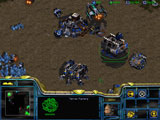
- The Terrans can build on flat and unobstructed ground. Note that the Factory is off-ground; almost all Terran buildings can relocate themselves, albeit very slowly.
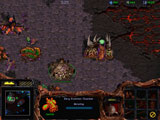
- The Zerg must mutate their structures on creep (purple, organic matter) and once built, they are completely stationary.
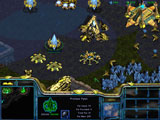
- The Protoss need to build inside the blue rings (the layer is only shown when a Pylon is selected). If a Pylon is destroyed, all building within its range stop working.
One of the cooler aspects of this game is the use of some units' special abilities. They're hard to master, but using these will definitely give you the upper hand. An example of a special ability is the Terran Science Vessel's EMP Shockwave; if the unit being fired at has shields or energy (energy is used to execute the special abillities), it loses all its shields/energy. This is particularly effective against the Protoss, since all their units have shields. Also, using the EMP Shockwave on other units with special abilities will render these units' special abilities completely useless, as they are dependent on energy. Another cool ability is the Terran Ghost's Lockdown. The Lockdown will simply disable and freeze (that is, the owner loses control of it) any mechanical unit it's fired at for a small amount of time. During the Lockdown the unit is completely vulnerable, can't move, and can't fire, so it's dependent on backup if it plans to survive. Fortunately, if you're playing as Terran, there's the Medic's Restoration ability, which restores the Lockeddown unit to its previous state. Ah, but then imagine a Science Vessel firing an EMP Shockwave on the Medic before she's able to administer the Restoration! See how these all tie together? Special abilities are very hard to master (and moreso during heated combat), but they are lots of fun!
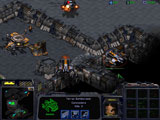
- A Science Vessel (top, middle) has just fired an EMP Shockwave in the middle of the two Battlecruisers.
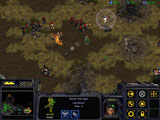
- A Ghost fires a Lockdown missile on a Goliath. At the top of the screen, a Wraith is Locked down and some Marines are firing at it.
The Zerg Queen has some interesting abilities. One of the most useful is the Parasite; it's completely harmless to the unit carrying it, but the owner of that parasite will now be able to view the areas over which the Parasited unit moves. Excellent for reconnaissance. The Queen can also launch a spore of green goo at targets, severely slowing down their movements, making it easier for you to take down melee units (units without ranged weapons). The Zerg Defiler's Dark Swarm is an effective tool if your units are being attacked by air units; when under the spore cloud, your units don't take any damage (with a few exceptions, such as when melee units run under the cloud and attack you). This can be a very effective method for protecting units that can only attack other ground units, but it becomes even more effective if your units can simultaneously take down the air units and avoid damage.
Linkage
- Official StarCraft site
- The StarCraft Compendium
- StarCraft.org —
The Number One Resource For All Things StarCraft.
- StarCraft legacy
The Prince of Persia series
“Had I really seen her? Or had my senses given way under the burden of horrors too great to bear, and conjured up a phantom?”
First, a little explanation: The Prince of Persia series consists of seven games. In chronological order of release, they are Prince of Persia, Prince of Persia 2: The Shadow and the Flame, Prince of Persia 3D (the first game in 3D), Prince of Persia: The Sands of Time (abbreviated SoT), Prince of Persia: Warrior Within (abbreviated WW), Prince of Persia: The Two Thrones (abbreviated T2T), and finally the ludicrously ill-named (but pretty fun) Prince of Persia. The first two games were developed by Brøderbund, and were spectacularly successful. They featured smooth animations, great puzzles, and excellent (albeit quite simple) swordpay. The third game, the first one in 3D, was developed by Red Orb Entertainment and wasn't very well received by fans (personally, I like this quirky little game). The next four are all developed by Ubisoft, and are a revamp of the series. The games feature totally new animations and a totally new story (unlike the first three games, the three last have one bounded story), and were generally very well received by fans. The latest game in the series, confusingly titled Prince of Persia, is also developed by Ubisoft, and is a new stab at revamping the series (the graphics are very cartooney and the acrobatics are even more fantastical).
In the first game, you play an unknown Persian prince who is thrown into a dungeon by an evil vizier, and you have one hour to make your way from your lowly prison to the top of the palace to slay the vizier and save the princess. The neat thing is that you have one real time hour complete the game; there's a countdown clock, and if you die, the level restarts (but the time doesn't stop). The thing that made this game great is the puzzles. The Prince (who has remained nameless throughout the series) can hang from ledges, must avoid motion-triggered floor spikes and dangerous metal saws, and fight guards along the way.
The third game, Prince of Persia 3D, is a little weird. The level design is somewhat arbitrary in places, the puzzles aren't always logical, and the controls are a little sluggish. Still, it's worth playing, if only for the weird atmosphere it provides (the music in this game is really good and makes the whole experience much more immersive).
For the last three games, the general consensus is that Sands of Time was a great surprise that breathed new life into the series, Warrior Within was somewhat of a flop that strayed too far from Sands of Time's style, and The Two Thrones was a sweet game that set things right again (I agree with the consensus).
Sands of Time starts by showing a Persian soldier running from his military camp in the veil of a rainy night to the palace his troops are to attack later on, making his way into the princess' sleeping quarters. He tells the princess to sit down while he tells her “a tale unlike any that you have ever heard”. He starts by telling her about his first battle alongside his father, conquering a neighboring kingdom (this is where the game proper begins). In his quest to make his father proud of him, he fights his way into the enemy's palace to retrieve the prized Dagger of Time, which he can use to slow down, speed up, or rewind time (in lieu of lives, SoT lets you rewind time a certain amount if you make mistakes, which drains so-called sand tanks that you must refill if you want to continue using the rewind feature). After the kingdom has been defeated, the victors travel the long way home with the treasures they have gathered (a big, mystical hourglass, the Dagger of Time, and concubines). Once home, the prince and his father proudly show off the loot to the sultan, who is immediately drawn to the hourglass. The vizier (evil, of course) is eerily interested in it, and eventually tricks the Prince into opening the hourglass with his Dagger of Time with promises of marvels beyond what any man has seen. Unfortunately, this lets loose the sand inside it, which spreads throughout the land, consuming and destroying; parts of the sultan's huge palace collapse and everyone, except the Prince, the vizier, and one of the plundered concubines (who wears a mysterious medallion), turns into hideous sand monsters. The rest of the game follows the Prince first as he tries to catch up to Farah (the woman with the medallion), and then as he and Farah try to set things right again.
The whole game is played as if the Prince is telling a story; he will interject comments about his situation while you do wild acrobatics, tell you his thoughts and his feelings about things, and if you fall down a hole and die (or are killed by sand monsters), he says witty things like "No, wait. That's not how it happened", and you are offered a retry.
The platform part of the game is really cool and intuitive. The Prince has a fairly impressive range of acrobatic moves at his disposal, such as wall-running, pole-swinging, and pillar-scaling, and these merge seamlessly into the gameplay (aided by extremely fluid animations). Sure, there's something a little unrealistic about someone taking eleven steps along a wall to clear an unjumpable gap, but the fluidity of the animations makes it look possible. There are dangerous, sharp traps in this game too, but unfortunately they aren't instantaneously fatal (like the previous games), which is a bit of a shame if you ask me. The game would be much more challenging had it featured difficulty levels, where the most difficult one had instant-death traps.
Where The Sands of Time is witty, cute, light, and features a sexy companion, Warrior Within is grim, harsh, dark, and doesn't. The Prince, he finds out in the game's intro movie, was supposed to die in the first game, so the Immutable Laws of the Cosmos (I made that phrase up; it's not in the game) has spawned the Dahaka, Fate incarnate, a big, metallic tentacle creature, to catch the Prince and see to it that he meets his fate (Final Destination, anyone?). The Prince is on the run from the Dahaka, and finally finds an old wise man who tells him that if he is to rid himself of his curse, he must travel to the Island of Time and defeat the Empress of Time. And so he sets sail with his crew to the Island. On the way, a guardian of the Empress and her crew attack his ship, and after fighting bravely to repel the attackers, the Prince is thrown overboard and later drifts ashore on the Island of Time, weaponless.
If you haven't played the first game, or if you're capable of momentarily forgetting it, you can play Warrior Within and get a solid gaming experience from it. The totally new fighting system is a welcomed change after Sands of Time's monotonous combat, and the platforming and puzzles are better. There is also this really neat feature of time portals, where you get to play the same area at two different points in time (one where the architecture is shiny and intact, and one where it is deteriorated and crumbled). Unfortunately, this makes for a ridiculous amount of backtracking, and the player ends up feeling a little cheated.
On the negative side, as mentioned before, this game strays really far in style from the last game. This is not necessarily a bad thing, but in this case it is. The most damning thing Ubisoft did was replace the voice actor for the Prince, and making him a killing machine with no feelings (“I smolder with generic rage”). Of course, you can ignore that and play the game for what it is, but this change in style really put a lot of fans off.
Then, The Two Thrones came around. I consider this the best game of the series. Early in the game, for reasons best undisclosed, the Prince's personality is split in two: One light side and one dark. The light Prince is noble and kind while the dark Prince is ruthless and arrogant. The dark and light Prince have small conversations during the course of the game, kind of like how the Prince in Sands of Time narrated his thoughts. Now the clever thing is that the light Prince is voiced by the same voice actor who voiced the Prince in Sands of Time, and the dark Prince is voiced by the same voice actor who gave Warrior Within's Prince the voice. Listening to their quarrels and discussions is fun.
The story follows directly from that of Warrior Within. After visiting the Island of Time (and doing his thing there; I try to avoid spoilers), the Prince returns to Babylon and finds it under siege. He must fight his way through the city and regain his throne, a quest which takes him almost throughout the whole city. Along the way, his character develops (as it did in Sands of Time and as it did not in Warrior Within), which is a really neat thing that is one of the main reasons this game is so good. Another reason is the awesome new moves the Prince has in his repertoire.
The latest game in the series, Prince of Persia, shows the unnamed Prince (who may or may not be the same prince from the previous games) being engulfed in a sandstorm while on a quest to save his donkey, only to be diverted from that task and delivered into the hands of a woman he quickly learns is on the run from soldiers. Elika (as she's called) has magic powers, and will save the Prince if he falls from heights or otherwise is about to die (which effectively means he can't die). The story is very intriguing, being based on Zoroastrian mythology. I won't reveal too much, but it's no spoiler to say that the story revolves around the struggles of a light god, Ormazd, and a dark god, Ahriman. The latter, evil, god is corrupting the lands, and the majority of the game is spent getting Elika to Fertile Grounds so that she can heal the land (when she heals a Fertile Ground, the entire area you're in becomes green with grass and generally more colorful). I think the general gameplay becomes repetitive pretty fast, but the vistas you traverse are very beutiful, which makes up for it. Also, the dialoge between the Prince and Elika is wonderful and entertaining.
The Deus Ex series
“It's about time they implemented some of this stuff.”
The first game in this series simply swept me off my metaphorical gaming feet, and it should yours too (the second one is good, but not Deus Ex-good). It's the future (or the relative future, anyway) of around 2055. Terrorism is rampant, governments are weak, and old conspiracies lurk in the shadows, planning to emerge. You play a UNATCO (United Nations Anti-Terrorist Coalation) agent, fresh out of the Academy, and the second in the line of UNATCO agents who are nano-augmented (all its former agents are biomechanically augmented).
This is one of the few games that really shows what an awesome planet we live on by setting all locations in the game squarely in the real world (well, the real world with a conspiracy theory bias and badass technology). You get to visit Liberty Island in New York, high-tech buildings in Hong Kong, an ocean lab in Pasadena, and Vandenberg Air Force Base. (A mission was planned to take place on Luna, but was sadly cancelled. You can still read about it in news papers scattered around the game world.)
The game is sort of a hybrid one. There are FPS elements like, obviously, the first person perspective, guns and gore, and jumping puzzles. Then there are some RPG elements like talking with NPCs, gathering items for your inventory, and levelling up your character (your choices in which areas to upglade you character really do make an impact on gameplay). In addtion to upgrading your character's ability to use different weapons, his swimming ability, etc., you can also install so-called nano-augs (nano-technological augmentations) into standardized areas in your character's body (such as the arms, legs, and torso) that increase his abilities in various ways (such as being able to jump longer, run faster, and lift heavy objects). These also affect gameplay, perhaps more so than the “normal” up-levelling.
An incredibly cool gameplay element is reading the contents of newspapers, public terminals, and computers that are scattered around the game world. And there's a copious amount of it. This really helps immersiveness.
Of course, Deus Ex has its flaws. The game's graphics are pretty bad, even for its time, and its AI is weak, but these are not serious shortcomings; they don't hurt the gameplay or the story, which are the two shining points of this game.
Deus Ex 2 is mildly off-putting. There are many serious flaws here. Chief among them is the console-like look and the removal of several good features from the first game (like note-taking and an intuitive inventory system). However, the game's story is very good, and the branching mission goals are even more intricate than those of Deus Ex. Also, its graphics and level design are really good. If you like the original game, you should play the sequel, if only for the story.
Linkage
The Half-Life series
“Gordon Freeman! It really is you, isn't it?”
These two games both put you in the shoes of Gordon Freeman, theoretical physicist-turned-mercenary (so to speak).
The first game starts by introducing you to the Black Mesa Research Center, a gargantuan self-sustaining complex of laboratories, launch sites, tram systems, and living spaces for its employees. Gordon Freeman is part of a team working on teleportation, and on the day the game starts, they've just recovered a very pure sample of an exotic crystal from the so-called borderworld Xen, an alien world they've been able to teleport to. Gordon is fitted in an HEV (Hazardous Environment) suit and is sent into a test chamber to do the grunt work while his collegues monitor his progress from the shielded control room above. Gordon slots the crystal into the analyzing beam, and an unexpected resonance cascade scenario occurs. For those of you who have never experienced a resonance cascade scenario before (let alone created one), it basically means that dimensional rifts are created, your research center crumbles, and aliens infest the place, which is exactly what happens to Black Mesa. Gordon, being in his HEV suit, survives, and the rest of the game is figuring a way out of the mess.
Half-Life is very often hailed as the best FPS ever, and it really is spectacular. For its time, the AI was really advanced (it's superceded by the AI in games like Halo and, ahem, Half-Life 2, but it still packs a punch). The graphics are dated, but the style is not. The architecture in Half-Life is incedibly consistent and well-made, and the changes between the different sections of Black Mesa (for instance, from the laboratories to the water processing area) are smooth and feel right.
Half-Life 2 takes place a number of years after the events in the original (consistently referred to as the Black Mesa incident). The aliens took over almost all of Earth in seven hours (an event referred to as the Seven Hour War), and only a few urban centers are left, with a small band of rebels trying (rather pathetically) to fight back. The old Black Mesa administrator, Dr. Wallace Breen, is installed by the aliens as interim-ruler-of-Earth-cum-sock-puppet for the Combine, an intergalactic amalgam of intelligent species, seemingly possessing near-infinite technology. Gordon is then suddenly (and mysteriously) dropped into the middle of this, arriving by train in City 17 (an Eastern European-looking city), run by oppressive trans-humans under Breen. Citizens are kept under close surveillance, are routinely harassed by Civil Protection (the local Breen-run cops), have had their reproductive urge suppressed, are carefully rationed food, and the only way to raise a citizen's standard of living seems for him to give in and join the trans-humans. Gordon links up with old Black Mesa friends, and manages to spark a revolution, instigating open rebellion against the trans-human wing of the Combine's presence on Earth.
The graphics are beefed up quite a bit from the first game, but the polygon count on the general architecture isn't much higher. Surprisingly, this is hardly noticable, due to the (still) consistent architecture, smooth transitions, and overall cleverness of the designs. The gameplay still has that Half-Life feel, only much more so: The enemy's AI is better, the puzzles are better (aided to a small degree by the totally awesome physics system), and the characters actually manage to make you care about them (aided by gorgeous animations and lipsync). The way the story is revealed is also pretty sweet, from Breen's occasional speeches to the conversations with rebels you meet along the way. You could play the game for the combat alone (I've chronicled a particularly interesting fight in a news post).
Linkage
- Planet Half-Life
- halflife2.net
- Half-Life Fallout
- My collection of links to Half-Life single-player modifications
The Homeworld series
“All that moves is easily heard in the void.”
On the world of Kharak, a planet covered almost entirely by desert, the Kushan (a humanoid race inhabiting said planet) find a spaceship buried in the sand and inside it a galactic map, which they call the Guidestone, showing the location of their homeworld. In the course of the next 60 years, the Kushan pool all their resourses and knowledge and develops hyperspatial travel along with a gigantic starship they call the Mothership that will take them to their homeworld (which they call Hiigara). Karan Sjet, their most brilliant scientist, volunteers to be permanently integrated into the core of the Mothership, and acts as Fleet Command. (Karan Sjet's voice is, in the author's opinion, the sweetest voice ever to appear in a computer game.)
This is, to my knowledge, the only strategy game where units can be moved in all three spatial dimensions, and the controls for this work very well: The mouse controls the 2-dimensional plane, while holding the shift key and moving the mouse backward and forward controls the last dimension, height.

- The movement disk. Notice how you can easily see if other ships are above or below the ships you're moving.
The story in Homeworld quite literally spans the galaxy and, as said, centers around the Kushan and their search for their homeworld. Their trip takes them through the heart of a nebula, uncomfortably close to a supernova, and even to the galactic core. The main antagonists are the Taiidan, another (I presume) humanoid race, who want the Kushan destroyed since they (unknowingly) broke a milennia-old treaty when they developed their hyperdrive (why they weren't allowed to develop hyperspatial travel is never explained).
Homeworld does huge, drawn-out spacebattles right; watching five Destroyers wreck havoc on some poor, unsuspecting Ion Frigates is pure bliss. In addition, all the ships you build in a mission (and that survive the mission) follow you to the next. In other words, your fleet is persistent. In the later missions, when your fleet is (hopefully) big, you'll feel a certain pride and attachment to it.
